*Collaborative Post.
When you hear “damp,” you think of time-consuming and expensive processes and mess in the home while a professional solves the problem. Dampness in the house is relatively common, and several tried-and-true solutions are available. Furthermore, the expense of dampproofing external and internal walls isn’t as high as you might believe.
The ancient Romans used damp courses constructed of lead, bitumen, or slate in their dwellings. However, in the United Kingdom, bitumen and slate impregnated hessian was not used as a DPC until the nineteenth century.

However, to prevent moisture from penetrating the bricks from the ground, all new houses now utilise a plastic waterproof covering. Furthermore, houses feature a cavity that prevents rain from entering the outside wall and damaging the plaster and internal fittings on the inside wall surface. Fortunately, most tradesmen’s straightforward solutions are relatively inexpensive and adequate for resolving most issues. Contact Advanced Damp for a free survey and quote for remedial work.
Dealing With The Rising Damp
Rising dampness is caused by weather moisture being moved upwards through the walls via capillary action. The water from the ground rises and penetrates via the substrate into the property.
Rising damp is tricky to tackle by yourself. So you would require seeking professional help from a damp expert. It is a complicated process to treat rising dampness, and it is pretty expensive, so you must have a rising damp survey carried out by an expert.
First and foremost, it is essential to check whether your house already has a physical DPC (damp proof course) in place or not. You can notice this locating a black line in between the mortar joints at low levels. It is usually bitumen, slate or a plastic membrane that prevents the water from rising the ground into your home via walls.
But, if you are facing damp issues despite having a physical damp proof course in your house, then it is recommended to get it checked. It might be damaged, or there must be another issue such as condensation, bridging, or salts.
The rising dampness in your house can occur where there is no DPC present, or it has been ineffective, faulty, or failed. Besides, rising dampness can also occur where the external ground levels are higher than the DPC.
The Costs of Rising Damp Treatment
It would help if you addressed the rising dampness as soon as possible. Failure to do so could result in damage to your property and your health.
The most typical solution for rising dampness is to install a chemical DPC, which involves removing plaster from interior walls, drilling holes into the walls, and introducing a chemical that will establish a barrier to more moisture coming up.
Repairing increasing dampness can cost a lot of money. The style of home you reside in, the severity of the damage caused by the damp, and the reason for the growing damp are essential considerations in determining how much you will pay.
The cost of treating increasing dampness in a terraced house is less than in a detached one. This is due to the fact that there are fewer external walls to contend with. The more walls you have, the more money you’ll spend on repairs.
It is a simple remedy to treat if another material bridges the DPC. But, it becomes more expensive if you need to replace the DPC for your entire home. It might cost as little as £400 to correct all the problems and damage in the most straightforward conceivable circumstance with minimal harm. But, if the problem is not addressed and causes substantial damage, you might be looking at a bill of up to £16,000.
Cost of Damp Proofing External Walls
If the external ground level is higher than the DPC level in the wall, the DPC becomes ineffective, and water can leak directly into the walls from the soil, causing wetness. To ensure that the problem does not recur, have the ground outside lowered by digging out the earth and covering it over, for instance, with concrete slabs or gravel. It may only cost £400 to £500 to dig up the dirt surrounding a modest house and install gravel. For a smaller home, adding a concrete path may cost £2,000, and for a larger home, it could cost twice as much.
Cost of Damp Proofing Internal Walls
Once the process is completed, replastering a decoration accounts for a large portion of the expense. The cost varies greatly depending on the area and the supplier, but a fair average is roughly £70 per metre of the treated wall or around £280 per wall. If you need to treat every wall in your house, the expenses may easily reach several thousand pounds. Besides, it may be less expensive to have the decorating and plastering done separately after the treatment.
Additional Costs
Apart from the above, there are some additional costs that you may also want to factor into your budget. For instance, labour costs, cost of materials, and others. In addition, removing all of the flooring, wallpaper/paint, plaster, skirting, sockets, and radiators from the space before the rising damp treatment and then re-applying them also adds to the total cost.
